
Download
in PDF Format
For people traveling through central Virginia,
Barboursville is pretty much on the way to wherever they�re going.
Intersected east and west by Route 33 and north and south by Route 20,
Barboursville has long been recognized as a stop on the way � whichever
that way was.
|
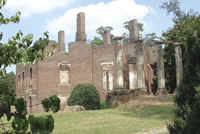
In
his design of Barbour's residence, Jefferson employed an
architectural signature that now symbolizes this estate---a
central, octagonal parlor the vineyard honors with the label of
its premier wine, Octagon. Barbour's home, once considered the
finest in the county, is a local historical site and home of the
Four County Players' summer Shakespeare at the Ruins series. |
But something happened about 30 years ago that woke
up the charming, rural community at the western end of historic Orange
County. Gianni Zonin planted grapes and during the next three decades,
Barboursville cultivated a rich blend of arts and culture and reaped the
benefits of rural tourism.
Barboursville is named for former Virginia governor,
statesman and diplomat James Barbour, who lived among the rolling hills
between influential neighbors and friends James Madison (Montpelier) and
Thomas Jefferson (Monticello). Barbour�s home was built in a
neoclassical Jefferson design that strikingly resembled the more famous
home to the south in nearby Albemarle County.
|
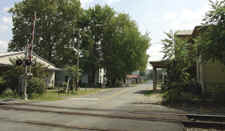
Today,
Barboursville's "downtown" features the Nichols Gallery
Annex, the Nichols studio, Sun's Traces Gallery, the community
post office and Masonic Lodge. |
According to local historian and author Ann Miller,
at its completion in 1822, Barboursville was the most elaborate plantation
in the county, valued at $20,000, twice as much as Madison�s Montpelier.
In the years following the Civil War, nearby
Gordonsville remained the commercial center of the county. But toward the
end of the 19th century, local railroad companies sought a more direct
connection from Charlottesville to Orange and found a viable route through
Barboursville and Somerset. Bypassing Gordonsville suddenly shifted the
commercial balance in the county toward Orange, with Somerset and
Barboursville as immediate beneficiaries, according to Frank Walker,
author of Remembering: A History of Orange County.
As traffic increased along the Rockingham Turnpike
(now Spotswood Trail, Route 33) Barboursville became a popular stop on the
new rail line. With the trade formerly bound for Gordonsville suddenly
stopping in Barboursville, the small crossroads community became a modest
commercial center. That prosperity lasted into the mid-20th century, when
Barboursville suddenly became a victim of highway construction.
|
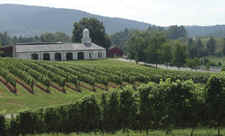
Baboursville
Vineyards |
�Barboursville had been a boomtown,� says Beth
Nichols, of Nichols Gallery in �downtown� Barboursville. �It had the
railroad depot and was right at the intersection of Route 20 and Route
33.�
But the depot closed and traffic found faster, more
direct routes with Interstate 64, a four-lane Route 29 and the Route 250
bypass.
�Charlottesville got the depot and the
crossroads,� Nichols notes. �By the 1970s Barboursville was a dying
town.�
Left behind were empty storefronts, vacant buildings
and little hope.
In 1976 Zonin, president of the largest private wine
company in Italy, visited Jefferson�s Monticello while touring the area.
During his visit, he learned of Jefferson�s unsuccessful, but repeated
attempts to grow European grapes in central Virginia�s soils.
|
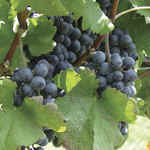
Barboursville
Vineyard cultivates 150 acres of grapes on the former
Barboursville Plantation. |
Zonin purchased the remains of the original
Barboursville plantation to establish a winery in the United States. The
fire-ravaged remains of the plantation�s original house were part of the
purchase and became the trademark of Barboursville Vineyards � the first
commercial winery in the region.
�Thirty
years ago, that was something new,� Barboursville Vineyards� General
Manager and Winemaker Luca Paschina says. �I�m sure somebody had a
good laugh about it.�
But Zonin�s vision opened the door to wineries
throughout central Virginia and slowly, Barboursville�s renaissance
began. As the grapes grew, so did Barboursville�s appeal.
�There was a lot less happening then,� Paschina
admits. �But we were already on a path of tourism from Montpelier to
Monticello. By producing a high-quality wine, we were able to create
greater visibility and generate that attention.� Soon, Barboursville
became a destination again.
|
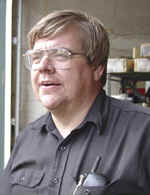
Mark
Johnson is active in the rural community. He's a member of the
fire company, president of the Ruritan Club, and represents
Barboursville and the surrounding area on the Orange County Board
of Supervisors. |
�A lot of small towns shrivel up and wither
away,� says Mark Johnson of Johnson Tire. Johnson serves as the chairman
of the Orange County Board of Supervisors and represents the county�s
western district, including Barboursville. �Barboursville hung in there
and got through the tough times.�
By hanging in there, Barboursville discovered its
identity. No longer simply a transportation crossroads, Barboursville
became a crossroads of art, culture and community.
Like many communities throughout Virginia,
Barboursville is an area, not an incorporated town. It has a �town
center� that includes the popular D�s Market convenience store, the
Barboursville Ruritan Building, the Four County Players� Playhouse, the
Barboursville Community Park and the Barboursville Volunteer Fire Company.
Barboursville�s �downtown� features the Nichols Gallery, Sun�s
Traces Gallery, the Masonic Lodge and the post office. A historic
freed-slave community � Careytown � and the wineries are just down the
road.
�There is a nucleus of activity that keeps the town
going and growing,� Johnson notes.
Between Barboursville Vineyards and nearby Horton
Cellars, nearly 100,000 visitors arrive in Barboursville annually to
sample the fruits of the vine. Thousands more visit the Nichols and
Sun�s Traces art galleries and even more come to Barboursville for the
impressive community theater productions presented by the Four County
Players.
|
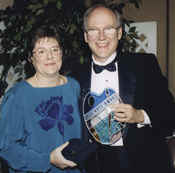
Frederick
and Beth Nichols work in the couple's Barboursville studio.
Nichols' silkscreen prints, watercolors and oil paintings capture
the beauty and depth of landscapes throughout the region. |
Their summer Shakespeare at the Ruins series, hosted
annually at the romantic and scenic remains of Barbour�s home,
represents a culmination of Barboursville�s history, agriculture and
cultural tradition. �We all really complement each other,� Nichols
notes. �It�s unique that there are three wineries just within minutes
of each other,� says Dennis Horton of Horton Cellars. In fact, just west
of Barboursville in Albemarle County is Burnley Vineyards. �Some people
think it�s competition, but it�s worked out very nicely,� Horton
notes. �We have a good relationship with each other.� That
relationship fuels not only Barboursville�s economy, but the county�s.
�It�s not just the money we take in,� Horton
notes. �A high percentage of the people who visit us stay at local
bed-and-breakfasts. They buy gas and shop here.�
�More and more people are putting us on their list
of places to go and things to do,� Nichols adds. �If one person has a
good experience, they�ll tell others. And Barboursville is a unique
experience.�
�There�s no other place in the state like
Barboursville,� says Jason Capelle, president of Friends of
Barboursville, a community advocacy group. �It�s got a historic
African-American community, the vineyards and it�s in a national
historic district. Barboursville is in position to take advantage of its
tourism industry. I see huge potential for Barboursville. I think it�s
just starting.�
|
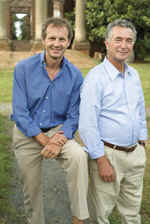
Barboursville
Vineyards General Manager and winemaker Luca Paschina came to the
winery as a consultant to owner Gianni Zonin. |
When Paschina moved from northern Italy to
Barboursville 16 years ago, people thought he was crazy. �How could you
trade the beauty of living in Italy for Barboursville?�� they�d ask.
�They don�t realize how beautiful it is and I do.�
Even with its steady flow of visitors from across the
state, Barboursville has remained true to its roots. �We still have the
feel of rural countryside,� Paschina says, �because it�s maintained
by people who are really true to the agricultural aspects of this
community.� The art galleries and community theater support that as
well.
�It�s really a unique combination and experience
with very historic roots,� he concludes.